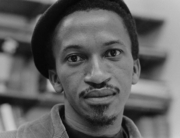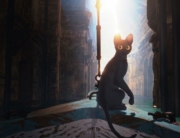![]() James Randi has many titles. As the “The Amazing Randi,” he’s a magician, mentalist, and escape artist, or as he would say at the beginning of his act, “a liar, a cheat, and a charlatan.” It’s this honesty in deception that separates him from those who claim to have actual psychic or supernatural powers. Thus, he’s also a professional skeptic, having devoted a large portion of his career to debunking modern mystics.
James Randi has many titles. As the “The Amazing Randi,” he’s a magician, mentalist, and escape artist, or as he would say at the beginning of his act, “a liar, a cheat, and a charlatan.” It’s this honesty in deception that separates him from those who claim to have actual psychic or supernatural powers. Thus, he’s also a professional skeptic, having devoted a large portion of his career to debunking modern mystics.
What directors Justin Weinstein and Tyler Measom accomplish in this highly entertaining documentary portrait is to depict Randi at a time in his life when the contradiction of being an honest liar catches up to him and several decades-old tricks refuse to stay hidden up his sleeve.
Interviews with notable colleagues and a trove of archival TV spots tell the remarkable story of Randi’s career. Little time is spent on his actual proficiency as a performer, or the young man who ran away from home to join the carnival. The real fascination here is in the crusades he waged. Like Houdini, his role model, Randi sought opportunities to expose the mechanisms of the fraudulent. Houdini was driven to this in part out of the pain he felt over his mother’s death. He wanted very much to be able to communicate with her, and angrily resented those who would presume to dishonestly profit from such grief. Randi had no such personal interest other than his sense of justice.
One problem is that some things, like channeling spirits, can be difficult to disprove. So Randi took a “join ’em” attitude, and created a spirit channeler, Carlos, complete with phony credentials and press kit. Randi was able to pack the Sydney Opera House, among other venues, and later exposed the event as a fraud. The only person channeled by Carlos, who was really artist Jose Alvarez, was Randi himself, through the help of an earpiece.
It was a trick he might have picked up from Peter Popoff, a faith healer and another of Randi’s targets in the 1980s. Randi still scowls when referring to the man as a scoundrel. Popoff took not only the money of his faithful audience members, but also their belief in the necessity of medicine and doctors, regularly asking the sick to throw their pills into the aisles. This is dangerous stuff, and Randi’s subsequent sting operation is thrilling and satisfying.
Probably his biggest campaign was against Uri Geller, a psychic who dazzled the likes of Barbara Walters and Kathie Lee by bending spoons. For a time, Randi would actually appear on shows directly after Geller’s appearance, replicating the man’s tricks one by one. Geller survived Randi’s attacks well enough to spend his sunset years hocking crystals on QVC. Even Popoff couldn’t be completely vanquished by the truth.
Nor is Randi a constant bedfellow to veracity. A surprise revelation near the end of the film provides the most tension and ambiguity than any of the magic shown throughout. Even the integrity of the filmmakers is called into question before the closing credits roll. Then, like a magician pulling back the curtain, all is resolved, but without the letdown that usually comes from learning how a trick is done. Instead, learning about James Randi and his belief in answers somehow makes the world more mysterious and so a little richer.







Leave A Comment